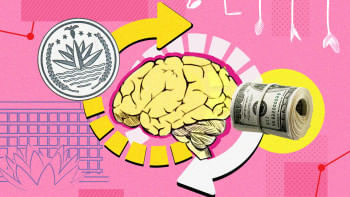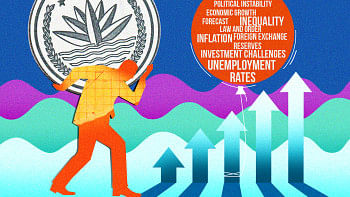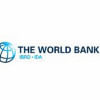Can Bangladesh's economy achieve its revised growth projection?

Some economic growth projections have been made for Bangladesh considering its current economic realities. In the latest projections, the World Bank has forecasted that the economic growth of Bangladesh for the fiscal year 2024-25 would be 4.1 percent. Earlier, the Asian Development Bank's (ADB) growth projection for Bangladesh for the same fiscal year has been 5.1 percent. These indicate three things: first, the numbers reflect the current economic realities of the country; second, even though there are differences in numbers, both the organisations have downgraded their earlier growth projections; and, three, economic growth projections have been made only by international organisations, but not by national entities.
The Bangladesh economy has shown some weaknesses in the last fiscal year and that has been reflected in the projections by the above organisations. For example, the ADB's forecast for economic growth for the current fiscal year has been downgraded from 6.6 percent to 5.1 percent. Similarly, the World Bank has downgraded its projection for the Bangladesh economy from 5.7 percent to 4.1 percent. The sluggishness in Bangladesh's economic growth has three dimensions—the legacy of global events during the last three to four years, the happenings in the Bangladesh economy in the recent past, and the current events in the country. In this context, it is pertinent to note that non-economic factors highly impact economic growth, even though economic forces mainly drive it, and future growth potentials must be discussed along with current growth patterns.
There is no denying the fact that like other economies of the world, global events over the past three to four years have affected the growth prospects of Bangladesh. Covid has paralysed the global economy as well as Bangladesh. It impacted the domestic economy, where the lives and livelihoods of people were at stake. Diversion of public resources to tackle the pandemic shrunk resources for both productive and social sectors, and Covid affected Bangladeshi exports to the outer world. For example, the RMG industry of Bangladesh was severely affected because of Covid. All these factors impacted the country's growth trend. Next came the Ukraine war, which disrupted the global supply chain. As a result, food and energy prices went up considerably. Since Bangladesh is a food and energy importing country, the global commodity price hikes have contributed to the domestic inflationary pressures, adversely affecting the country's growth prospects.
Besides, the economic growth scenario during the tenure of the last government should be analysed in terms of two issues. First, the reliability and the robustness of the growth data—so many official growth figures used to float around, with so many revisions and projections that trusting one single number for any fiscal year became quite difficult. Added to this was the multiplicity of growth data published by various official entities. Second, the economic mismanagement by the past government also made the country's economic growth quite volatile. Discretionary decisions at the state-level; crises in the banking sector in terms of defaulting loans, bad loans, and money laundering; and the absence of transparency and accountability in economic decisions and implementation have led to widespread corruption, economic uncertainties and different instabilities in the economy. Naturally, economic growth could neither thrive nor sustain under such circumstances.
The current political structure has inherited an economy with huge challenges. The present state of the economy needs to be fixed as there are volatilities and instabilities. Fortunately, some declining trends have improved. For example, remittance flows have surged, foreign exchange reserves have improved, money laundering has been mostly halted, and exchange rates have stabilised. In the banking sector, measures have been taken to assist failing banks, to reconstitute the management structure of the banks, and to restore the faith and trust of the people in the banking system.
Yet, in the present economy, there are both economic and non-economic reasons, which have slowed the economic growth in Bangladesh. On the economic front, continued high inflation has impacted the growth rate adversely. The inflation rate still remains near 10 percent. This rate is high compared to our neighbours. Over the past two years, Sri Lanka has been able to reduce its inflation rate from 70 percent to less than one percent. Even if the global inflation rate is on a downward trend, the inflation rate in Bangladesh is stuck at a high level for quite some time. High inflation erodes economic growth.
There has been a deceleration in economic activities for various reasons and economic activities are yet to be optimal. For example, the production in the RMG industry is yet to reach its normal level. Industrial production in other sectors has to recover from the disruptions, it has gone through. As there are economic uncertainties, both domestic and foreign investments are not coming in as desired. The banking sector is still not in good shape. The law and the order situation face different vulnerabilities. As a result, there seem to be fewer growth opportunities. The recent floods, on one hand, have destroyed the lives and livelihoods of people as well as the wealth of households, and on the other, they have adversely impacted the production base of the affected areas. Even though the exact impact of the floods on the growth prospects is yet to be clear, the widespread floods in a vast area of Bangladesh are expected to affect the economy's future growth.
A deceleration of economic growth will shrink the economy and impact the country's social sector. The overall economic impacts would depend on the sectors which experience the maximum effects. Over time, the manufacturing sector has led to jobless growth, not leading to any new job creation. Under such a circumstance, a sluggish industrial sector may not result in large employment losses, while a slowdown in service sectors may have significant impacts on people's jobs and income. With high inflation and declining growth, social sectors such as healthcare, and education would be adversely affected. In the process, the poor and the marginalised would be affected the most.
These are the current realities of the Bangladesh economy. But even with all the uncertainties, volatilities and instabilities, the economy is expected to overcome all the growth hindrances in the coming days. With the continued improvements in the economic management on all frontiers, the Bangladesh economy is expected to be on an enhanced growth trajectory, with the trust and the confidence of the people on a solid base, higher investments both by local and foreign investors, and further improvements in the law and the order situations in the country. Reforms in the banking sector, stable policies in the external trade sector, and ensuring stability in the manufacturing sector would contribute to the process. If the supply of agricultural inputs including seeds and fertilisers is ensured, the agricultural sector may hold on to its past growth rates of four percent. In the ultimate analysis, if Bangladesh's economy achieves a growth rate of about five percent, that would be considered favourable under the present circumstances.
Selim Jahan is the former director of UNDP's Human Development Report Office at UNDP in New York.
Views expressed in this article are the author's own.
Follow The Daily Star Opinion on Facebook for the latest opinions, commentaries and analyses by experts and professionals. To contribute your article or letter to The Daily Star Opinion, see our guidelines for submission.

 For all latest news, follow The Daily Star's Google News channel.
For all latest news, follow The Daily Star's Google News channel. 










Comments